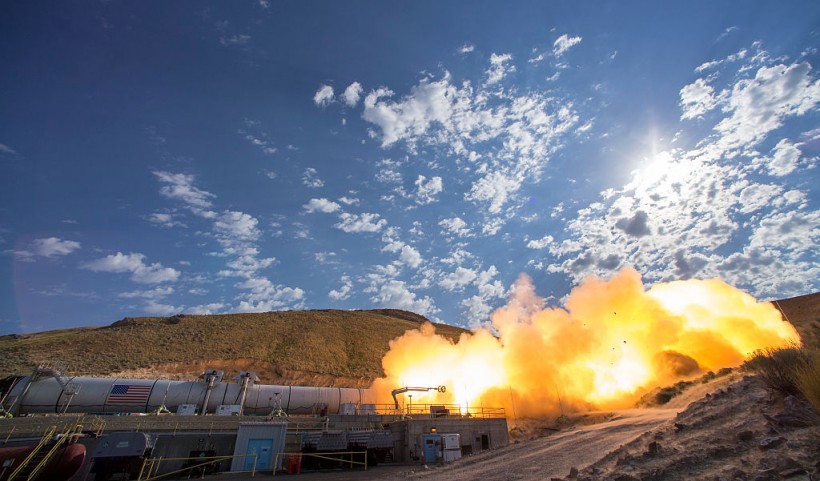Having conquered the Moon, the next frontier for humanity lies on Mars, a celestial challenge demanding swift and efficient long-distance space travel.
In a groundbreaking achievement, NASA recently tested an advanced rocket engine with the formidable thrust needed for swift journeys to the Red Planet, marking a significant leap forward in interplanetary exploration. This innovation paves the way for future Mars exploration.

In this handout provided by NASA, The second and final qualification motor (QM-2) test for the Space Launch Systemâs booster is seen, Tuesday, June 28, 2016, at Orbital ATK Propulsion Systems test facilities in Promontory, Utah.
RDRE Breakthrough: A Milestone in Space Propulsion
NASA's achievement in developing the Rotating Detonation Rocket Engine (RDRE) marks a significant milestone. RDRE underwent its first hot fire test at Marshall during the summer of 2022, conducted in partnership with In Space LLC and Purdue University from Lafayette, Indiana.
The recent test had the primary objective of gaining a deeper understanding of how to adapt the combustor for different thrust classes. This adaptation is crucial for supporting various engine systems, catering to a wide array of missions, ranging from landers to upper-stage engines and even exploring supersonic retropropulsion - a deceleration method that could facilitate the landing of larger payloads, potentially including human missions, on Mars.
ThomasTeasley, the lead engineer for RDRE testing at the Marshall Space Flight Center, emphasized the monumental impact of RDRE on design efficiency, signifying a substantial leap forward. He underscored the engine's role in the creation of lightweight propulsion systems, bringing NASA closer to the realization of sending increased mass and payload deeper into space.
This development aligns seamlessly with NASA's ambitious Moon to Mars vision. Collaborative efforts between NASA's Glenn Research Center in Cleveland and Venus Aerospace in Houston, Texas, are actively exploring avenues to scale the RDRE technology for even higher performance in future space endeavors.
READ ALSO: 3 Months Travel to Mars: Possible With New Nuclear Rocket Engine Design
Recent Ignition Trial Surpassed RDRE's Initial Test
Engineers at the Marshall Space Flight Center successfully conducted a 251-second test of a novel, 3D-printed RDRE, generating over 25,810 newtons (5,800 pounds) of thrust. This sustained burn aligns with requirements for maneuvers such as a lunar lander touchdown or a deep-space burn for interplanetary journeys, demonstrating the engine's versatility.
The RDRE's breakthrough lies in its utilization of a sustained detonation within a ring-shaped channel, ignited by a mix of fuel and oxygen. The recent test surpassed the 2022 result of 17,800 newtons (4,000 pounds) of thrust, affirming the project's progress towards developing a fully reusable 44-kilonewton class RDRE to enhance traditional liquid rocket engines.
What makes the RDRE revolutionary is its ability to achieve stable and manageable sustained detonation, a technology in development since 2020. The innovation reduces propellant fuel consumption compared to conventional rocket engines, making space exploration more cost-effective and enabling extended travel distances.
Additionally, NASA's use of 3D printing techniques for durable machine parts underlines the advancement in manufacturing technology, ensuring components can withstand the extreme conditions inherent in RDRE design.
Having conducted the test, the engineers now have a more comprehensive understanding of how the combustor could be scaled and adapted to support different thrust levels, various engine systems, and mission classes.
NASA aims for the first human steps on Martian soil in the 2030s, with numerous challenges to overcome. Efficient propulsion addresses a significant obstacle in reaching and surviving on Mars. Watch the video below for NASA's 3D-printed RDRE test:
RELATED ARTICLE: Engine for Blue Origin's New Rocket Exploded During Testing Last Month: What Caused This Mishap?
Check out more news and information about Tech and Innovation in Science Times.



![Earth's Quasi-Moon Kamo‘oalewa Could Originate From Lunar Surface Not Asteroid Belt [Study]](https://1721181113.rsc.cdn77.org/data/thumbs/full/53275/89/56/50/40/earths-quasi-moon-kamo-oalewa-could-originate-from-lunar-surface-not-asteroid-belt-study.png)










